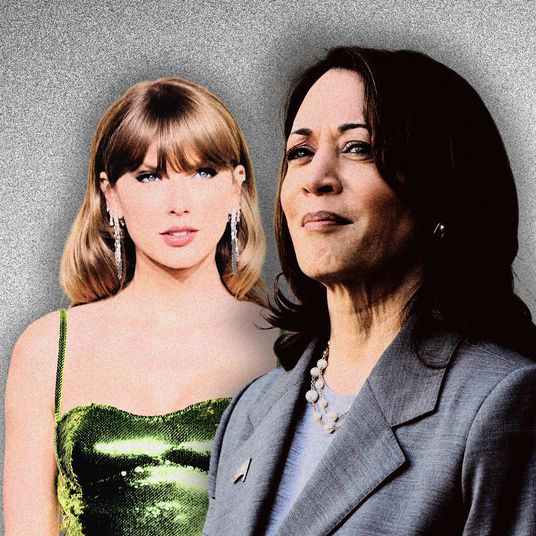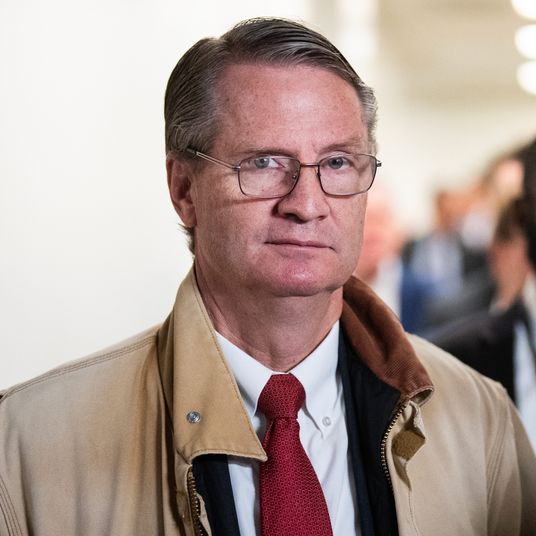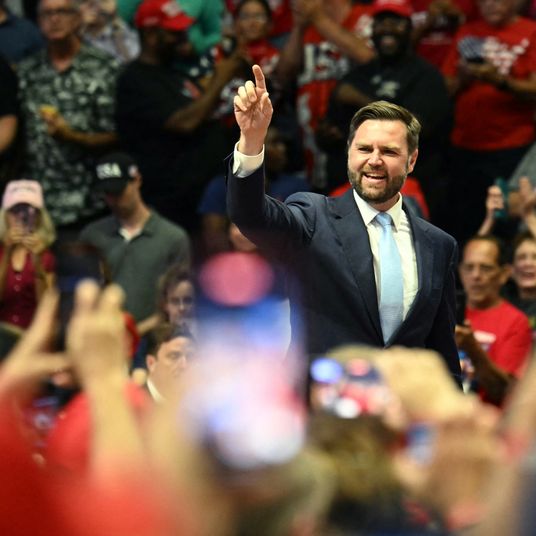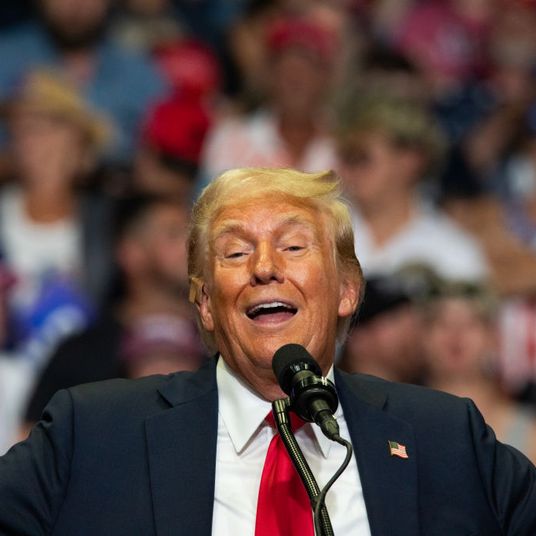
Bill Clinton’s disappearance from the daily political fray has been more or less total for at least half a decade. So when the former president emerged late last month on the campaign trail, it was clear something was up. There he was promoting Sean Patrick Maloney, the representative who runs House Democrats’ campaign wing while suddenly playing defense in his own Hudson Valley district. And then, before long, there Clinton was in the next district over, appearing with the similarly vulnerable representative Pat Ryan. In the midst of this unexpected return, Clinton also released a video focused on gun control in an attempt to reprise his role as Democrats’ “explainer-in-chief.”
To those who know how to read between Clintonian lines, the message was sent. The last time he took on that mantle was in 2012, when he thought his team was in trouble with a message desperately in need of refining. This time, with just days left in midterm season and Democrats on the defense in once-safe territory like Maloney’s, more or less the entire party infrastructure feels that way.
The feeling around Democratic leaders in Washington, D.C., and campaigns across the country can charitably be described as “on edge” in recent weeks, as Republicans took back the generic-ballot lead in polling averages for the first time since the summer and a series of surveys popped up showing tighter races than anyone could have fathomed even in Democratic strongholds such as New York and Washington State. They are resigned to a generally bad result and realistic about the lack of time left to change the course of races with anything other than get-out-the-vote pushes. But they are unsure just how bad it will be. Almost no one in the party still claims Democrats can hold the House, but there is far less consensus about anything else, starting with the fate of the Senate, where they still have a hope of winning plenty of toss-ups and keeping control.
So in come the reinforcements. Barack Obama, who’s been crisscrossing the country, made plans this week to appear in Pittsburgh with Pennsylvania lieutenant governor John Fetterman, who led polls in his Senate race until a recent, startling fade. It will be Obama’s only rally for an individual candidate and not a full Democratic ticket, indicating the degree of importance the party is putting on Fetterman’s race. Not long before Obama touched down in the Keystone State, Oprah Winfrey took the surprise step of endorsing Fetterman after refusing to weigh in on his race against Mehmet Oz, who shot to fame on her show. And other prominent figures in the party have been scheduling new appearances in states with priority Senate races: Bernie Sanders in Wisconsin and Pennsylvania, Elizabeth Warren in Nevada, Pete Buttigieg in Nevada and New Hampshire. The push, which comes as party vessels also pump final resources into last-ditch ad efforts and while campaign and union door knockers blanket the states, represents Democrats’ final bet at saving their as-slim-as-possible majority.
Most of the national party’s concern focuses on Senate races that were always thought to be competitive but that Democrats were assumed to have an advantage in until recently. Polling averages now show the races in both Pennsylvania and Georgia as dead heats, for example, after months of Democratic leads. For at least half a year, party leaders have believed that Donald Trump’s insistence on meddling in GOP primaries helped the Democratic cause since Republicans were nominating unelectable figures. Yet with Oz, Herschel Walker, and others such as Blake Masters and Don Bolduc within striking distance of the Senate — and Democrats thus forced to spend money on defense that they’d prefer to be using in offensive territory — the “It could have been so much worse argument” is a relic. “There’s no doubt that Republicans nominated the worst crop of Senate candidates that I’ve probably seen in my lifetime,” said one prominent Democratic strategist. But “the fact that Arizona and New Hampshire have come back into play, that’s devastating.”
It’s now clear this election won’t represent quite as bad a wipeout for Biden’s party as 2010 was for Obama. Back then, “everything went against us. There was massive popular opposition to the Democratic agenda. That is not the case this year at all,” said Josh Schwerin, a longtime Democratic operative who worked on a House campaign that cycle. “There’s no question it’s a tough political environment for Democrats, and there are economic factors making it challenging for us, but Republicans are not running against the actual Democratic policy agenda. It is much more of a vague, atmospheric argument.”
Yet party officials are now wondering whether they’re stumbling into a repeat of 2014. That year, according to Schwerin, who was then at the Democratic Congressional Campaign Committee, “is a closer comparison, especially given that,” going into Election Day, “there were more questions about how bad it would be and what the outcome would be.” The result of that cycle was a GOP-led Senate that stonewalled Obama’s agenda and set the stage for the eventual conservative dominance of the Supreme Court.
Now, scrambling to avoid a similar fate in that chamber and in governors’ mansions, Democrats are pulling together a flurry of last-second activity in usually blue territory.
Evidence of closing-stretch nerves has not exactly been in short supply even beyond the Senate contests. New York governor Kathy Hochul, who was expected for months to coast in her contest against Trump-friendly representative Lee Zeldin, started in recent days to bring in unexpected big-name reinforcements. Around the time a handful of polls showed her race to be in single digits, she announced a Manhattan event with Hillary Clinton and, soon after, added Vice-President Kamala Harris to the playbill. This attempt to consolidate her standing with women voters comes as she pushes to shore up support with Black New Yorkers, especially in the city — she held an appearance with Mayor Eric Adams came and is running ads featuring young voters of color vouching for her — and to weaken her opponent’s standing among suburbanites worried about crime. A surprise last-second spot from the Democratic Governors Association features the brother of Capitol Police officer Brian Sicknick, who died in the aftermath of the January 6 attack, ripping into Zeldin for refusing to support an investigation “into the violence against the police.”
Hochul has plenty of company in calling for help. Even Biden is spending time in what should be safe territory: Just a few days ago, no one in Democratic leadership would have anticipated a final-stretch event in New Mexico, a distinctly blue-tinged purple state where Governor Michelle Lujan Grisham held a comfortable polling lead until the past two weeks. Yet Biden swung through Albuquerque on Thursday to warn voters, “It’s clear this is not a referendum. This is a choice. A choice between two vastly different visions of America.”
The amped-up worries come in large part thanks to a spree of unfriendly polls and independent evaluations. These have been landing at a rapid-enough clip to make political pros ignore the fact that both parties regularly reach into unlikely territory in the closing days of campaigns. Hillary Clinton’s nominal late-2016 investments in Texas come to mind, as do Trump’s 2020 visits to Minnesota. But election analysts in particular have turned their trickle of race-rating changes in favor of Republican candidates into a river. (As I wrote this column, my inbox pinged with more: The University of Virginia Center for Politics’ Crystal Ball site was updating its ratings on five competitive House races, four of them in the rightward direction. As I submitted it, Politico colored three more Senate races, 12 more House races, and four governors contests a darker shade of red. A few hours later, news broke that Hochul is bringing in Biden for a last-second rally, and shortly thereafter, she announced an event with Bill Clinton.)
There’s little evidence Biden faces any more personal backlash than previous Democratic presidents in their first midterms. While much has been made of his relatively sparse presence in top battleground states, he has in fact campaigned roughly as much as Bill Clinton did in 1994 and only slightly less than Obama did in 2010, though Biden has relied more on his ability to raise money via video and teleconference than his predecessors. And though Obama has gained outsize attention this cycle for being Democrats’ most in-demand surrogate, this is not unique, either: A similar dynamic played out with Bill Clinton playing the role of popular ex-president opposite Obama as under-siege commander-in-chief a dozen years ago.
Nonetheless, Biden can take little comfort in facing better odds than in 1994 and 2010, which were both historic wipeouts for Democrats. This year’s vote may not reflect a straight up-or-down referendum on his presidency, but operatives around him still see a landscape built to disadvantage his party.
“The races have tightened,” conceded Celinda Lake, a leading Democratic pollster who worked on Biden’s 2020 campaign. But, she told me, “we could have predicted that a number of them were going to tighten because for a long time Republicans were not consolidated.” It’s a familiar and unwelcome pattern for Democrats, who are finding they can no longer hope for a fractured GOP in the Trump era. Still, Lake continued, the numbers show a hardening of right-wing support, not a broad-based move toward Republicans among genuine independents: “You have to distinguish between shifts that are occurring where the Democrats are losing the last swing voters and races that are tightening because the Republicans are coming home.”
The issue is that this consolidation is happening quickly and that it is bringing some previously undecided voters with it just as many Democrats are working to ensure their solid supporters stick with them and actually vote. For this, most of the strategists close to Biden’s White House blame the grim national mood around the economy. Independents “break against the party when you have economic diagnostics like we’re seeing. End of story, done,” Biden’s other pollster, John Anzalone, told The Wall Street Journal. “Voters trust the Republicans on that, right now. That’s tough sledding for us.”
In many races, this leaves Biden’s party tripling down on a message that worked for them this summer. Lake said that, in the polls and focus groups she’s been studying, abortion remains the best motivating topic for Democrats’ GOTV efforts.
Still, the finger-pointing has predictably begun even before the scale of losses are known. And though Biden’s allies are confident he is not primarily to blame, he is starting to come in for quiet criticism within his own ranks.
The late shift toward GOP candidates has come because “the underlying fundamentals kicked in. It was clear even back in August that we were taking a victory lap way too early,” said the Democratic strategist. For this veteran of decades of races, the party’s jubilant posture late this summer following a successful legislative stretch caused it to overlook Americans’ persistent concerns. “Voters are not stupid. They don’t see gun violence fading away — they still think gun violence is a problem — and we’re tut-tutting around about the accomplishment” of passing the first serious gun-control measure in 30 years, he said. Similarly, he argued that calling the latest major piece of legislation the “Inflation Reduction Act” was a risk when voters remain so concerned with inflation.
That argument is a cousin of the one that popped up in the past week, when Biden announced plans to speak one more time about the looming threat to democracy and the rise of political violence. David Axelrod’s tweet on the subject was passed around plenty among nervous operatives: “Issues of democracy are hugely important at this moment and in next week’s election. Totally appropriate for @POTUS to address them,” Obama’s former top political adviser wrote. “Still, as a matter of practical politics, I doubt many Ds in marginal races are eager for him to be on TV tonight.”
Lake, who had no hand in the speech, said her ongoing research showed that January 6 and its related threats remain significant motivators for Democrats and some swing voters. And, she noted, this is now a GOTV environment.
Still, few vulnerable candidates have been centering their opponents’ election denialism in their closing-argument ad campaigns or canvasser messaging. And just as popular among the political-professional crowd as Axelrod’s tweet was a clip of Sanders’s former campaign manager Faiz Shakir on MSNBC before the speech. In it, he faced Chuck Todd and said he hoped White House aides were watching: “I’d hope that they’re rewriting it and focusing on cost of living.”






























